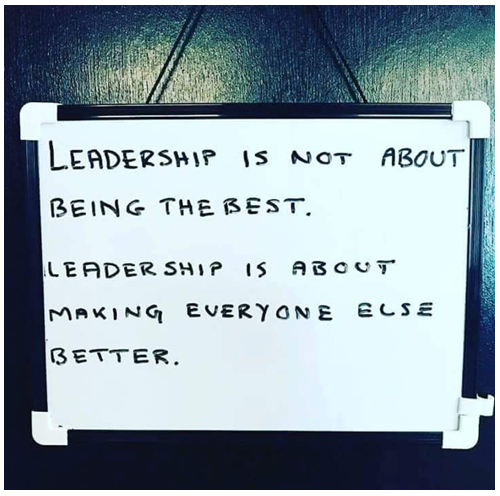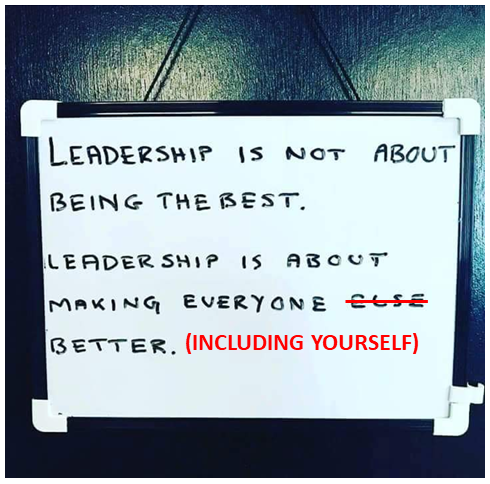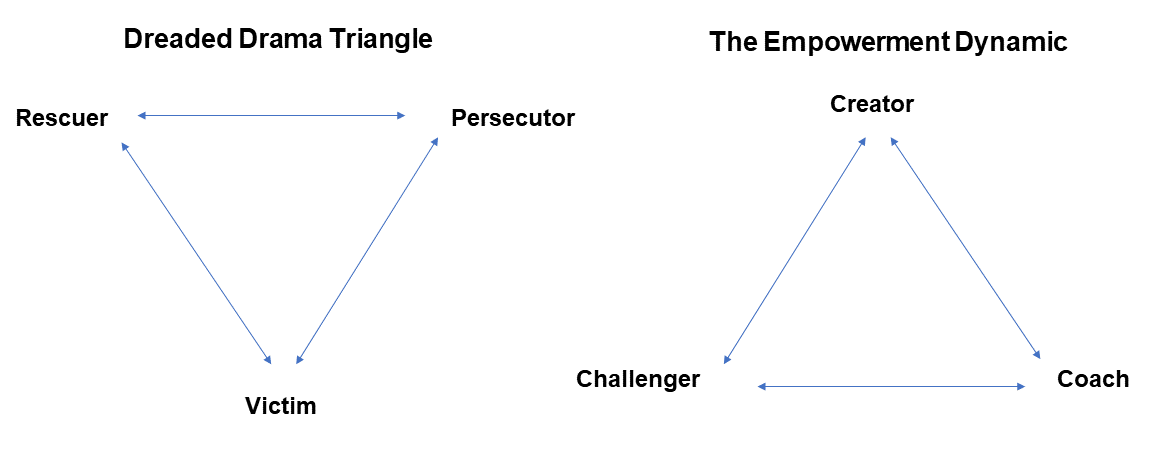This quote recently went viral on social media.

I have a few modifications to it.

One important way leaders make everyone better (including themselves) is by empowering their colleagues to be their best, to try new things, to share their opinions and ideas. This leads to a win-win scenario where the employee is motivated, invested and productive while the business spends fewer resources managing staff and reaps the benefits of new, creative ideas/programs/initiatives that keep the business competitive.
Outcomes of Empowerment
|
Outcomes for the employee
|
Outcomes for the business
|
|
Sense of purpose
|
New, creative business ideas and models
|
|
Feeling of ownership & responsibility
|
Cost savings from less turnover and micromanagement
|
|
Motivation & investment in the work
|
Motivated, inspired staff and work environment
|
|
Portfolio of successful programs/projects
|
Increase in sales and profit
|
Increase in sales and profits?
Yes. You read that last outcome correctly. It has been proven over and over that Firms of Endearment (a term coined by Raj Sisodia, David Wolfe, and Jag Sheth) regularly outperform the S&P 500 firms by large margins. In fact, the companies featured in the first edition of their book Firms of Endearment: How World-Class Companies Profit from Passion and Purpose returned 1,026 percent for investors compared to 122 percent for the S&P 500.
The Firms of Endearment that they studied include companies such as Patagonia, Whole Foods Market, Stonyfield Yogurt, and Adobe Systems. However, you don’t have to be a national or global company to increase sales and profit by implementing a conscious culture. Companies of all sizes are seeing the benefits to leading with empowerment. Companies of all sizes can be high-trust organizations.
High-Trust Organizations
Empowerment leads to trust, which is another element of having a conscious culture. As a leader, once you empower your staff and realize they can do so much more – you trust them with larger projects and trust them to lead programs and implement ideas. But trust also goes the other way. As a staff person, once you have been empowered to take ownership over a project – you trust that your leader has your back. You trust that you have the support and guidance you need to do a great job – and be your best self.
Also, it’s worth mentioning that empowerment does not only have to be between a boss and a subordinate. Empowerment can come from anyone at any time. Any time you are working with another you can both empower each other – regardless of your title or position in the org chart.
Many high-trust organizations – such as Southwest, Google, The Container Store and IDEO - build in time for social events and playfulness. Similar to how families take family vacations and have family dinners, high-trust organizations create opportunities to connect. These connections lead to a deeper trust between colleagues, as well as trust between staff and the business/organization.
How to Lead Using Empowerment
The Empowerment Dynamic
David Emerald presented at a Conscious Capitalism Chicago event and shared The Empowerment Dynamic with us. The Empowerment Dynamic is a positive approach to problem-solving. The focus is on turning a reactive disposition into a proactive orientation. See the diagram below. The Victim at the bottom of the Dreaded Drama Triangle becomes the Creator at the top of The Empowerment Dynamic, taking control of his/her actions and response to problems and obstacles.

We all play each role of the triangle at different times. At times, we feel like we are the Victim. “I’m getting dumped on. I always have to do everything. Why is this happening to me?” This is the mindset of the Victim. On the other hand, the Creator understands he/she is empowered to choose how to respond to each situation and is focused on the outcome of the situation versus dwelling on the scope of the problem.
At times, we all play the role of the Persecutor. The Persecutor often times dominates the Victim’s time and energy (think project manager, boss, etc.) and is often seen by the Victim as the source of the problem and feeling victimized. Interestingly, the Persecutor often sees the Victim as the problem. In The Empowerment Dynamic the Persecutor becomes the Challenger. The Challenger is empowered to do his/her job while being focused on learning and growth, constructive criticism, and trust.
Finally, at times we all find ourselves sympathizing with either the Victim or the Persecutor and our natural instinct is to save the person. This role is called the Rescuer. We’ve all been there. We decide the Victim is right and we confront the Persecutor. Or we think the Persecutor is in an unfair position, so we try to intervene. Or, more common yet, we simply want the pain and discomfort to go away, so we jump in and offer to handle it ourselves. “I’ll just do. It will be faster if I do it. I’ll take this on so you no longer have to worry about it.” These are all very reactive responses to the situation.
In The Empowerment Dynamic, the Rescuer becomes the Coach. The Coach supports and assists the situation. The Coach may facilitate a conversation to foster clarity. The Coach asks questions and delivers options and solutions to the situation that are outcome-driven. And the Coach does this without taking the burden on him/herself.
But, how do I do that?
First of all, leadership comes from all levels of the org chart. The Empowerment Dynamic is not just for management. Every one of us can lead – and empower.
Here are some specific steps:
- 1. Lead by example. The next time you feel like the Victim, take control of the situation and become the Creator. When the time comes (and it will) that you realize you are the Persecutor, rethink your approach and become the Challenger. And the next time you find yourself swooping in to be the Rescuer, pause, adjust, and become the Coach instead.
- 2. Be respectful. Be respectful – always. It doesn’t matter if the staff person you’re working with is above you or below you in the org chart. Treat him/her with respect.
- 3. Have integrity. Integrity is not how you treat your superiors, but instead how you treat those around you when no one is watching.
- 4. If you are a manager - invest time in hiring the right staff. We’ve all heard the phrase: “Spend more time hiring and less time managing.” It’s true. You should hire people with big ideas - ideas that are better than your own. The fear of having a subordinate be more creative or more strategic holds some leaders back. The best leaders I know welcome the challenge and create the space for that person to shine. You need to empower those staff members to vocalize those creative ideas and then put them in a position to lead the implementation of those great ideas. You must think of your staff as thought partners – and stop thinking of them as task masters. Once you make that transition – hold on! Your world will shift for the better VERY quickly and catapult your business or organization to the next level.
- 5. Focus on the outcomes. Do not get caught up in the drama, the process, or the intensity of the situation. Instead, say calm and envision the desired outcome. Then create incremental steps to reach that vision.
And remember, leadership is not about being the best. Leadership is about making everyone better (including yourself).